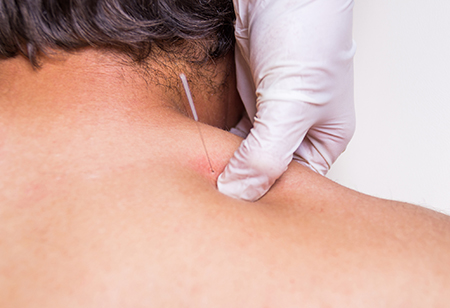
Kylie Scott, a physical therapist at HonorHealth Spine Group Arizona in Scottsdale, explains that therapeutic dry needling can release pain, ease acute inflammation and promote healing in your body.
1. Dry needling can help reduce pain and soreness.
If you're fine with thin, sterile needles that don't involve much, if any, pain, you might consider this therapeutic technique if your physical therapist recommends it. A specially trained physical therapist uses a thin needle to release muscle tightness, ease tendonitis and inflammation, and/or promote healing.
"I use it with about 30% of my patients at Spine Group Arizona," Kylie said. "I've had good success with it over the last three years while using it in combination with manual techniques and exercise."
2. How does dry needling work with chronic muscle tightness?
It stimulates a trigger point in a skeletal muscle. You might call it a knot, and it can cause more widespread pain than just the muscle in which it's found. Another name for a trigger point is myofascial pain syndrome. A tight band of skeletal muscle inside a larger muscle group, a trigger point can be tender when you touch it and may cause pain in other areas of your body.
As part of a larger treatment plan, your therapist is using dry needling to try to release the trigger point, relieving pain and/or improving your movement. Dry needling can reduce muscle tension and improve pain. A twitch can occur when the needle goes into the trigger point, and may be a sign that the therapy is working.
3. Where do trigger points often occur?
On your neck, back and arms. Runners often get them on their legs. But there are many conditions that dry needling can help including:
- Shoulder pain.
- Headaches.
- Knee pain.
- Achilles tendonitis.
- Sciatica.
- Plantar fasciitis.
- Hip and gluteal pain.
4. Therapeutic dry needling promotes healing.
The technique also can help with muscular issues that don't involve trigger points or such as rotator cuff damage. The needle creates a tiny lesion in the tissue, promoting blood flow and healing to the area.
5. Dry needling is different from acupuncture.
The two philosophies are quite different. Therapeutic dry needling is based on Western medicine. Acupuncture is based in Chinese medicine and focuses on balancing the flow of energy in the body.
6. No liquid is involved.
The needle itself produces release in the trigger point. There's no solution injected into the muscle.
To make appointments for dry needling, contact HonorHealth Spine Group Arizona.